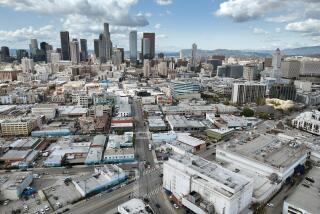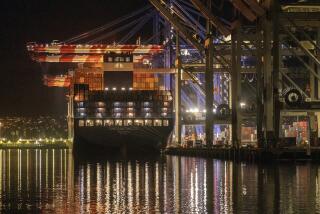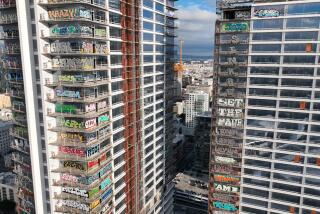Study Cites Lack of Clear Plan for Future Bayfront Development
- Share via
A study initiated in response to the Navy’s proposal to build a massive office and hotel complex along San Diego Bay has found that “the major problem on the (central) bayfront is the lack of clear, comprehensive and publicly agreed-upon vision for future development.”
That observation, contained in an interim report released Thursday, is based on the fact that development along the central waterfront is dependent on the sometimes-conflicting strategies of multiple jurisdictions--including the Navy, the San Diego Unified Port District, San Diego County, the City of San Diego and the Centre City Development Corp.
With that in mind, an effort will be made to bring together the top elected and appointed officials of those agencies in an extraordinary joint meeting in November.
Such a meeting could eventually lead to the recognition of one agency to spearhead and coordinate planning or to the creation of a new agency altogether.
Could Become a Mishmash
Without such coordination, the 10 million square feet of offices, hotels and other types of construction proposed on the central waterfront over the next 15 years could become a mishmash of development and degrade one of the city’s major assets and landmarks, the report says.
“There is unanimity about what the issue is . . . but not necessarily unanimity in how to solve it,” Mike McLaughlin, a planner with the San Diego Assn. of Governments, the regional public agency coordinating the study, told members of the Broadway Complex/Bayfront Coordinating Group.
The group--which is composed of representatives of all the agencies with jurisdiction over land use near the central waterfront and private developers--was formed last year after the Navy announced plans to convert its downtown naval base and supply center into a 6,000-worker regional “corporate headquarters” involving about 4 million square feet of high-rise offices and hotels. The development was known as the Broadway Complex.
There was concern among many agencies that the Navy’s plan, which envisions as many as eight high-rise structures on its 16-acre parcel that spans eight blocks, would dominate the downtown waterfront and perhaps cause chaos with other development plans for downtown.
$75,000 Study Funded
As a result, the public agencies agreed to finance a $75,000 study to evaluate the proposal and its impact on downtown, and selected Sandag to coordinate it. That study, which was started last spring by the NBBJ Group of Seattle, was soon expanded by the consultant to include not only the proposed Navy development but also all current and future growth in a 270-acre swath of the central bayfront bounded by Hawthorne Street, 8th Avenue, Kettner Boulevard, Harbor Drive and the bay.
So far, the consultants have held a series of workshops and the Broadway Complex/Bayfront Coordinating Group--which includes representatives of the Navy--has met several times. The report released Thursday says the central bayfront is under considerable development pressure. It found:
- “The absence of comprehensive land-use policies to guide sought-after development.”
- “Public perceptions that the existing policies of the port and city are too general.”
- “The absence of mechanisms to coordinate inter-agency decision making.”
- “An apparent lack of citizen trust in major public landowners.”
- “Perceptions that there is a need for leadership in planning the bayfront’s future or a valuable asset will be lost.”
Despite the presence of several parks and open space “amenities” on the waterfront, such as the Broadway Pier and the bayfront promenade, the report says that, overall, there is limited public access.
‘Captured’ Open Space
“Open space around the Seaport Village and Inter-Continental Hotel are considered ‘captured’ or belonging to the developments that surround them and are therefore not perceived as open to the general public,” the study stated. “Some open space, such as much of the waterfront promenade, is poorly defined and lacks identity.”
Ironically, the report says that, if anything, there is too much open space on the bayfront but it is “in the form of surface parking lots, vacant parcels or right of ways that are too wide instead of open space that is usable by the public.”
As for the waterfront’s strengths, the underdeveloped nature of much of the area means that future growth can be “positively influenced” and that both physical and visual linkages within the bayfront and downtown can be improved.
The next step in the evaluation of the bayfront is for the various public agencies to convene in November and discuss what needs to be done to better coordinate the area’s future development.
“We have to try and get them to agree on some planning mechanism to resolve these type of (multi-jurisdiction) conflicts,” McLaughlin said after the meeting.
More to Read
Sign up for Essential California
The most important California stories and recommendations in your inbox every morning.
You may occasionally receive promotional content from the Los Angeles Times.













